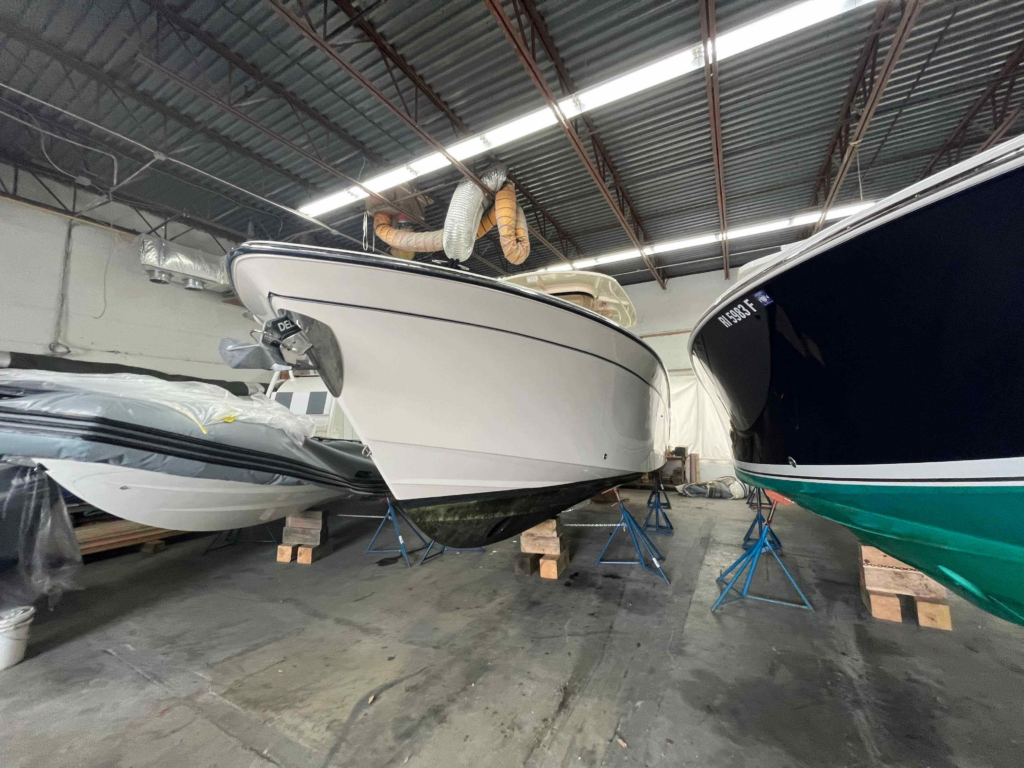Dear Survivor,
Your Survival Guy hauled the Tom Sawyer recently, a reminder to all that if you want a good weather weekend in the fall, just ask me when I’m hauling. It was beautiful.
Here’s a picture of Tom Sawyer tucked away for the winter. You know the popularity of center console boats, but I want to show you her deep-V hull to explain why.
Back in the 1950s, sail and powerboat designer C. Raymond Hunt developed the deep-V hull, a revolutionary design that makes these types of boats so popular. What made Hunt’s discovery unique was how he carried that deep-V or dead-rise angle (less of an angle amidship to stern than in the bow) all the way to the transom.
With the deep-V running the length of the hull and not a flat area in the stern, it revolutionized the ride. No longer were you two bugs on a board bouncing around in the slightest of chop. She cut like a knife.
If you’ve ever ridden in a flat-bottomed Boston Whaler ’13 (also designed by C. Raymond Hunt) like Your Survival Guy did as a kid, you know exactly what it’s like to be a bug on a boat. Its flat hull slams into chop like a hammer. But as a kid, that’s no big deal.
The other unique qualities of the Hunt hull were the stringers or strakes running bow to stern along the bottom of the hull, which you can see in the picture above. These help lift the boat, aiding in gaining speed and lifting her to ride along the surface. They also aid in stability to reduce roll and channel spray down the hull, making for a drier ride. And that’s how Hunt built a better boat.
Handling the Tough Water
“According to Hunt, two fiberglass 23’ prototypes were built. Each had a centerboard and an engine mounted amidships,” writes Stan Grayson in Boat Crazy.
As many of you know, Newport, Rhode Island, was host to the America’s Cup races for decades. “During the 1958 America’s Cup trials off Newport, Rhode Island,” explains Grayson, “one of these Hunters served as tender to the wooden Hunt-designed 12-Meter Eastener. The boat, flying the Eastern Yacht Club’s burgee from a staff on the bow, was often driven by Hunt’s son Josh, with Hunt’s wife Barbara sometimes aboard. That’s where people first noticed the design. Those who noticed the boat—and they were many—observed how smoothly it ran in rough seas without reducing speed. At rest, it looked like a displacement hull, but then as it gained speed the boat lifted out of the water in a manner nobody had ever seen.”
As an owner of a deep-V hull and frequent traveler of the seas outside my homeport, Newport, RI, I can tell you the C. Raymond Hunt designed deep-V hull performs as advertised. Even in the roughest of seas, Your Survival Guy has felt comfortable knowing how Tom Sawyer handles rough water. It always seems to be rough and windy off Brenton Point in Newport. Perfect for 12-Meter sailing and a Hunt-designed deep-V hull.
A Wide White Road, Key West, and Boat Races
If you’re in Key West, Florida, from November 2nd through the 9th, be sure to make your way to Truman Waterfront Park to check out the 44th annual Offshore World Championship. Festivities begin with a parade down Duval Street on Sunday, November 2nd at 4:00 pm. Races begin on Wednesday, November 5th, with plenty of practice runs in between. It is quite the spectacle. But I’m getting ahead of myself, because perhaps if it wasn’t for C. Raymond Hunt, there may not be a parade or races at all.
Let’s head north up Route A1A, shall we? Because it was on the morning of April 12, 1960, when Dick Bertram boarded a 30’ powerboat called Moppie.
“The boat’s driver, Sam Griffith, steered her into the smooth waters of Miami’s Government Cut,” explains Stan Grayson in Boat Crazy. “Griffith had Moppie’s two big Lincoln engines burbling away at just above idle speed as he and twenty-two other racers waited for 7 a.m., when the flag would drop and send everyone off in what the Bahamas Tourist Bureau billed as ‘The Most Rugged Ocean Race in the World.’”
Also aboard was yachtsman and writer Carleton Mitchell who writing for Sports Illustrated explained, “Even to one unfamiliar with the type it was obvious she was a wonderful sea boat: 30 feet over-all, built to designs by C. Raymond Hunt of Marblehead in the yard of Richard H. Bertram in Miami by workmen only recently from Havana, Moppie’s underwater form was unusual—V-shaped not only forward but all the way back to the transom.”
When the flag dropped to begin the 185-mile race, “I was slammed back into my chair as Skipper Sam Griffith gunned the engines, the fleet dropped astern and the wake stretched like a wide white road back toward our nearest competitors, a road that grew steadily longer,” wrote Mitchell.
“Nothing could really have prepared Mitchell for the violence of it,” writes Grayson. “He had placed a tube of sunscreen 7’ away and, for the next seven hours, never felt it was safe enough to try and reach it.”
Of course, Moppie won the race, by a lot, pounding through some 10’ seas created by the intersection of the Gulfstream and 30-knot northeast winds. The only other competitor they saw well off their stern was the spray of Jim Wynne’s twenty-three-footer, Aqua Hunter, whose hull was designed by—you guessed it—C. Raymond Hunt.
What Does a Sailboat Have to Do with Center Consoles?

By Wangkun Jia @ Adobe Stock
If you’ve ever been to Duxbury, MA, and been on a boat, you know how important it is to keep within the channel markers or risk running aground. It’s a perfect place to grow oysters with its plentiful flats and twice-a-day tides rinsing in and out of the Atlantic.
It also happens to be where C. Raymond Hunt grew up and, at an early age, was known as a sailing prodigy. Racing within the ever-changing depths of the harbor, Hunt was masterful at reading the wind and current and maneuvering the centerboard like a guitarist plays chords. As he got older, it was said, he could smell the air for changes and use that “feel” to his advantage.
Junior sailing was a big deal in the 1920s, covered regularly by The Boston Globe and New York Times. After one win, Hunt and his two crew members were invited to shake hands with the President of the United States, Calvin Coolidge, who was summering nearby, and who also happens to be my favorite.
When Hunt designed the one-class sailboat, the International 110, shaped like a cigar, he envisioned a hard chine. The chine is where the side of the boat meets the hull. A hard chine forms a right angle. In Hunt’s mind, he could see that when healing over, this hard chine would create a V, allowing the hull to knife through light chop. It turned out, he was right.
You don’t need to be a boat designer to be creative. Sometimes it’s simple concepts that can work wonders for generations. When you want help designing your retirement life, let me know. Email me at ejsmith@yoursurvivalguy.com.
Survive and Thrive this month.
Warm regards,
“Your Survival Guy”
- If someone forwarded this to you, and you want to learn more about Your Survival Guy, read about me here.
- If you would like to contact me and receive a response, please email me at ejsmith@yoursurvivalguy.com.
- Would you like to receive an email alert letting you know when Survive and Thrive is published each month? You can subscribe to my free email here.
P.S. In my conversations with you, you’ve been telling me about your retirement life and the trips you’re looking forward to taking. It feels like sweater weather here this morning, and it makes me look forward to going hiking in New Hampshire in a week or so.
In one conversation this week, you told me how you visited your son, who lives in the Rockies, and how, along with your cousin, the three of you climbed a 14,000-foot mountain. That’s impressive, especially considering you and she are of the age where you’re required to take a required minimum distribution from an IRA. “Oh, yes,” you said, “She and I did Kilimanjaro ten years ago.”
“OK, you’ve done this before,” I said.
The 10-hour day on the mountain began at 6am. In the dark. It was cold. 26 degrees. And the hiking was slow, even with the aid of headlamps. At the first creek crossing, you told me, you stepped on a big boulder, did not see the black ice, slipped, and fell backwards into the freezing creek water, completely submerged. The next two hours, you were miserable, finally warming up and drying out by hour four, and pushing on.
“No, thank you,” I said.
When asked about provisions, you told me you each carried a gallon and a half of water in your Camelbaks, electrolytes, trail mix, and four tall boy IPAs. “My son carried those,” you said. “It’s a tradition to have a beer when you reach the summit of a 14,000er. We shared the other one with a fellow hiker we met.”
You don’t need to climb into the clouds to have the retirement life you deserve. Just getting out there and changing your routine can do wonders for your psyche.
P.P.S. When it rains, it pours. Reminds me of a Luke Combs song. And the stock market.
Seems to me a lot of investors are playing the stock market like it’s the lottery, using their winnings to double down in a zero-sum game. Because for every losing lottery ticket there is a winner.
Your Survival Guy sees how retirees or soon-to-be retirees suddenly pay more attention to their portfolio the closer they get to needing it to survive on for the rest of their lives. They focus on reaching a certain number or level as if the market cares.
This is where the desire to use leverage to “juice” returns often comes in, a close cousin of the “stop” loss. Neither cares what price you want. They come a-knockin’ in the name of a margin call and rely on a dried-up buyers’ market that will not pay your stop loss price. Remember, there needs to be a buyer in a zero-sum game.
Don’t treat your money, especially your retirement money, like a winning lottery ticket. Because when the music stops, the trading does not.
P.P.P.S. How you livin’? By the sound of our conversations, I’d say pretty darn great. Just this week you gave me your itinerary for the private jet tour around the world, in another conversation you told me about your 16 day float trip down the Grand Canyon this coming spring, I know from another talk you’re fishing in Alaska, yet another about your golf game in Scotland, a separate talk about your Paris lunch, and much, much more.
For many of you, you’re getting ready for your southern migration to see your second family of snowbirds down south, while others are watching the snow fall out west, gearing up for some fresh tracks at Snowbird and other spots where some are already making turns.
Life is good. That’s what it’s like when the haves and the have yachts enjoy a market melt-up. How long will it last? How much snow will we get this year? As you know, I don’t like the prediction business.
I’ll tell you what I do like, and that is knowing thyself. I know my risk tolerance, and for many of you, it’s lower than you think. Only you know you. Isn’t it time to beat inertia, take a hard look in the mirror, and adjust accordingly? This is your retirement life we’re talking about. And I want you to have the one you deserve. When you’re ready to talk, let’s talk. Email me at ejsmith@yoursurvivalguy.com
Download this post as a PDF by clicking here.





